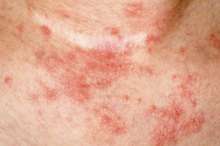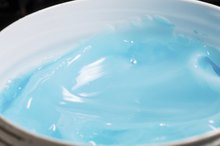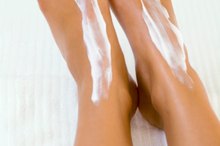Uses of Clobetasol Propionate Cream
Clobetasol propionate cream is a topical steroid that reduces inflammation, itching, redness and swelling caused by certain skin conditions. It is a Class 1, or “super-potent,” corticosteroid typically used once or twice a day for two weeks or until control of the condition is achieved, whichever comes first. Skin treated with clobetasol propionate cream should not be covered or bandaged as this will increase the amount of medication absorbed into the body and may cause steroidal side effects. Clobetasol propionate is much stronger and more toxic than other topical steroids, according to Drugs.com.
Psoriasis
Health care providers use clobetasol propionate cream to treat moderate-to-severe psoriasis that has not responded to other treatments. Psoriasis is an autoimmune disease that most often causes red, raised skin lesions covered with a silvery-white scale of built-up dead skin cells. Apply clobetasol propionate cream sparingly to affected areas, using no more than 50g each week. According to the National Psoriasis Foundation, at least half of the 7.5 million people afflicted with psoriasis also have it on their scalps. Usually, the solution and ointment forms of clobetasol propionate are used on scalp psoriasis, while the cream and lotion forms are used on the face and body.
- Health care providers use clobetasol propionate cream to treat moderate-to-severe psoriasis that has not responded to other treatments.
Eczema
What Is Ammonium Lactate Lotion?
Learn More
Clobetasol propionate cream also reduces scaling and relieves itching of atopic dermatitis, or eczema. Eczema is a chronic skin condition causing inflammation and severe itching, which is usually worse at night. It occurs in patches, most often on the hands and feet, the inside forearms, neck and upper chest. It may also affect the eyelids. Eczema occurs most often in children but often lasts into adulthood. According to MayoClinic.com, although studies have not shown “pediatric-specific” problems that would limit the usefulness of clobetasol propionate in children over age 12, it should, nevertheless, be used with caution due to its toxicity. It is not recommended for children under age 12.
- Clobetasol propionate cream also reduces scaling and relieves itching of atopic dermatitis, or eczema.
Seborrhea
Seborrhea affects the body where there is a high proportion of sebaceous glands. The glands are attached to hair follicles and secrete an oily substance that lubricates the skin. Seborrhea often occurs in the middle of the chest, around the navel, in the folds under the arms and breasts, and around the groin and buttocks area. On the face, it can affect the forehead, nose, and ears. When seborrhea affects the scalp, it’s called dandruff; in babies this is known as “cradle cap” and usually disappears by 6 to 12 months of age. If seborrheic dermatitis does not respond to other treatments, your doctor may prescribe clobetasol propionate cream or ointment. Do not use it for more than two consecutive weeks and do not use more than 50g in one week, Drugs.com warns. Clobetasol propionate is not recommended for children under 12 years old.
- Seborrhea affects the body where there is a high proportion of sebaceous glands.
- When seborrhea affects the scalp, it’s called dandruff; in babies this is known as “cradle cap” and usually disappears by 6 to 12 months of age.
Related Articles
References
- National Psoriasis Foundation: Learn
- National Psoriasis Foundation: Specific Locations: Scalp
- Chong M, Fonacier L. Treatment of Eczema: Corticosteroids and Beyond. Clin Rev Allergy Immunol. 2016 Dec;51(3):249-262. doi:10.1007/s12016-015-8486-7
- Physician's Total Care, Inc. Clobetasol Propionate Cream Prescribing Information. Published April 2012.
- Rajabi-Estarabadi A, Hasanzadeh H, Taheri A, Feldman SR, Firooz A. The efficacy of short-term clobetasol lotion in the treatment of scalp psoriasis. J Dermatolog Treat. 2018 Mar;29(2):111-115. doi:10.1080/09546634.2017.1341616
Writer Bio
Based in Arizona, Kira Jaines writes health/fitness and travel articles, volunteers with Learning Ally and travels throughout the Southwest. She has more than 16 years of experience in transcribing and editing medical reports. Jaines holds a Bachelor of Arts in telecommunications and journalism from Northern Arizona University.








